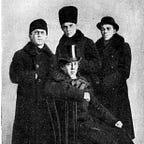Time and Somethingness: On T****oian Art Within P***cian Bounds
Art begins when one person, with the object of joining another or others to himself in one and the same feeling, expresses that feeling by certain external indications (signs).
Right off the bat we see a hole (sign) we can burrow through to get to Peirce, but we’ll be taking another hole, or route.
The let down many atheists have when reading Peirce is that his understanding of “real” is not typically how they use the word when they say “God is not real.”
God may be real in the sense that we say He’s responsible for so many deaths, regarding religious martyrs and wars that have been fought in His name. The sly atheist may avoid the semantic hole by saying “More people have died in the name of God than any other name” so as to side-step granting God any properties directly.
It’s easier to dismiss a being as less than us if it doesn’t have any property.
For the pragmatic atheist, then, realness may be valid but unfounded/unbounded/soundless.
Then art may be valid, real without sound.
What does the sound add? What dimension is sound?
Truth. Inconclusive or otherwise. Art.
Indeterminate arrowing. Towards without bearing.
But what about man’s intent to communicate something? Abstraction must be contained.
How can something be real but not art? Or how can something be art and not real? How does something make the transition from one to the other? Not art into art — not real into real.
Create meaning to rearrange in a certain way. Or to give something aimless a destination. Gestaltwandel.
Embed or bound something without borders into something with an edge. Or rather contextualize something within a conduit.
Somethinging something into somethingness.
Nothingness only appearing interwoven into part of reality. Borderless forever. Glimpses within decisions. Decisions that can be right or wrong, true or false, invalid but sound, soundless but valid.
God exists, but He shouldn’t.
This is what is. But it could be better. We should strive for it to be better.
We should replace what is with what is not. Then we’ll be happy. Or rather, happiness will be attainable.
A leap of faith into inexperience. Running back into the woods to recreate civilization again but with the experience of what not to do. Let’s not cut down as many trees or displace as many animals. Let’s not disturb the ecosystem but let us still have books and pantries.
Let’s bound everything but in a different way.
Let’s redefine what pragmatism means. What is real and what is not. Not because it’s not real. But because it’s more beautiful when it’s noughting.
The question turns into — does man’s intention, purveying through the cosmos, become less than art when there is no reception for it. Does offering a sacrifice to the ether take away from the suffering? Or does a god need to see it for the suffering to be real?
How is the movements of atoms different than the movement of an object propelled by the intention of art? Can atoms become art? Or has there always been art within atoms regardless of whether or not they’re touched by man?
